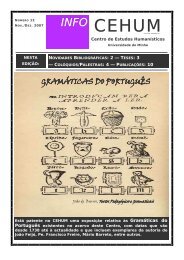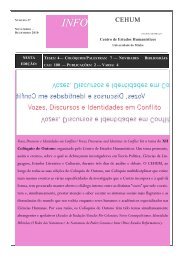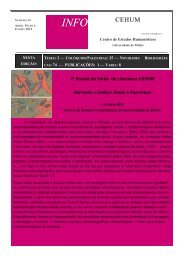Diacritica 25-2_Filosofia.indb - cehum - Universidade do Minho
Diacritica 25-2_Filosofia.indb - cehum - Universidade do Minho
Diacritica 25-2_Filosofia.indb - cehum - Universidade do Minho
You also want an ePaper? Increase the reach of your titles
YUMPU automatically turns print PDFs into web optimized ePapers that Google loves.
170<br />
GEORGINA ABREU<br />
Queen’s case: ‘the ruling gang have long triumphed over the people [...] and<br />
the Queen of England would have fallen a sacrifi ce to their machinations,<br />
had not the people unanimously vindicated her cause’ (R, vol. iv: 406).<br />
Ironically, however, the victory of the Queen emptied the popular agitation<br />
of its motive and favoured counter-attack by the loyalist press. Th e<br />
edition of the BD of 13 December refl ected the new situation, when loyal<br />
addresses began to fi nd their way into the press. Th e scorn and mockery<br />
thrown in the BD upon the writers of loyal addresses in the letter ‘To the<br />
Wise Men of Gotham, Resident ion the Ward of Cheap, in the City of Lon<strong>do</strong>n’<br />
(BD, vol. v: 835-6) was no longer a symptom of force. It was a melancholic<br />
ending.<br />
Pamphlet satire and the Queen Caroline affair – William Hone<br />
Arise, O Satire! – tune thy useful song,<br />
Silence grows criminal, when crimes grow strong;<br />
Of meaner vice, and villains, sing no more,<br />
But Monsters crown’d, and Crime enrobed with Power!<br />
William Hone, 1821, Th e Right Divine of Kings to Govern Wrong<br />
Satiric laughter erupted in satirical prints, pamphlet satires, mock advertisements,<br />
ballads, and broadsides. Unlike the benevolent, aseptic and sometimes<br />
nonsensical type of humour that came aft erwards, disengaged from<br />
direct relationship with public fi gures and public aff airs, [14] satiric laughter<br />
made truth claims in relation to its referential object and attacks were scathingly<br />
personal. Satiric laughter conveyed attitudes of contempt rather than<br />
fear, anti-authoritarianism rather than deference, towards the established<br />
authority.<br />
It had been prepared by technological innovations [15] and by the extension<br />
of literacy among the lower classes that lowered the price and acceler-<br />
14 W.T. Moncrieff Th e March of Intellect, A Comic Poem (Moncrieff , 1830) is an example of this<br />
type of humour. It is also found in Punch, Lewis Carroll (Charles L. Dodgson, 1832-1898), and<br />
Edward Lear (1812-1888). George Cruikshank’s 1828 print Th e Age of Intellect, from ‘Scraps and<br />
Sketches’ is another instance.<br />
15 Th ese technological innovations consisted essentially of the introduction of wood engraving, a<br />
technique developed by Th omas Bewick (1753-1828), and of rapid mechanical improvements<br />
in printing presses. Unlike copper-plate engravings, engraving on wood allowed the drawing<br />
of highly detailed images and the production of thousands of copies on conventional printing<br />
presses.<br />
<strong>Diacritica</strong> <strong>25</strong>-2_<strong>Filosofia</strong>.<strong>indb</strong> 170 05-01-2012 09:38:28











![Programa [pdf] - cehum - Universidade do Minho](https://img.yumpu.com/17305425/1/190x135/programa-pdf-cehum-universidade-do-minho.jpg?quality=85)




